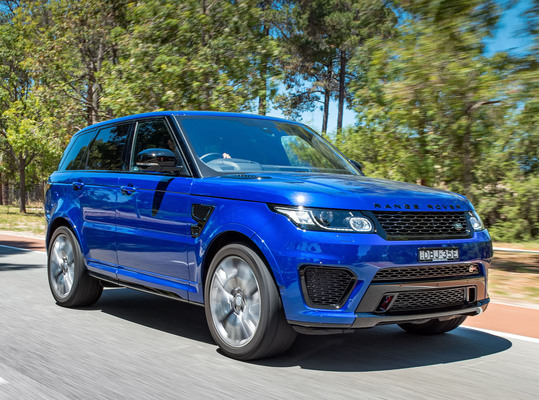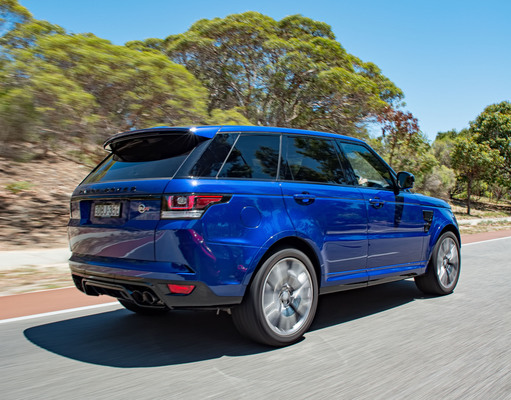
By Ewan Kennedy, Marque Motoring
Range Rover Sport SVR is one of hardest accelerating 4WDs on the planet.
Its 405 kW 5.0-litre supercharged V8 has it screaming from zero to 100 km/h in just 4.7 seconds.
This is a genuine off-road vehicle that can handle harsh conditions that would have many so-called competitors stuck within the first few metres.
For example, wheel travel remains identical to the standard Sport, with 260mm at the front and 272 mm at the rear.
Wading depth continues to be to ‘real’ off-road standards 850mm.
So we’ve just spent a week in real world road testing of an SVR, that is boring motorways, clogged peak hour traffic, shopping centre carparks and so on.
Range Rover Sport SVR makes a strong visual statement, including a new front bumper with trapezoidal air intakes.
There’s dark Range Rover script on the clamshell bonnet, which has revised vents.
Its new grille has a dark finish that contrasts with the headlights’ graphics.
And all-new aluminium fender panels incorporate a new design of vents while unique side mouldings add further muscularity.
At the rear there’s a high-level spoiler with a central brake light. The revised rear bumper features a gloss black diffuser and houses the SVR’s quad exhaust pipes.
Inside, the Sport’s sport seats are finished in luxurious Windsor leather with ribbed, quilted centres, Ebony Black top stitching, eye-catching reflective piping, and all feature the Range Rover Sport SVR logo.
Range Rover Sport SVR uses an evolution of the company’s all-aluminium 5.0-litre supercharged V8 engine.
It has cast-iron cylinder liners and cross-bolted main bearing caps among other features often found in ultra-high performance engines.
Larger air intakes in the front bumper increase airflow to the two charge-air coolers.
This reduces the temperature of pressurised air generated by the supercharger before it enters the engine thus producing high performance even in extreme conditions.
The eight-speed ZF 8HP70 automatic transmission has been optimised and now receives additional torque in its lower gears.
We fell in love with ‘our’ Range Rover Sport SVR, not only because of the virtually instant acceleration provided by a supercharged engine – no turbo lag here – but also because it sounds the part.
The SVR has a two-stage active exhaust featuring electronically controlled valves.
A racecar-like soundtrack produces a purposeful, modulated pulsing at lighter throttle openings combined with a higher-frequency, staccato sound as you approach peak performance. Yet it’s not so loud as to upset the neighbours.
In country driving on our favourite test roads we experienced the delights of Range Rover’s Corner Recognition technology.
Among other features it watches steering input and maintains one gear through a bend to provide stability that could have been hampered by unnecessary ratio changes.
It recognises that the bend has straightened and that the driver may then want to accelerate hard. Clever stuff.
Torque Vectoring by Braking is recalibrated over that of the standard Rangie Sport and provides more extreme handling when desired, balancing the distribution of engine torque between the four wheels to reduce any understeer that might try to spoil the fun.
Active-Roll Control (ARC) replaces traditional anti-roll bars and uses actuators powered by a hydraulic pump to reduce body roll, adapting up to 1000 times a second. It’s tuned to behave specifically for the Sport SVR during performance driving.
Cleverly, it automatically reverts to the same software map as other Range Rover Sport derivatives once it senses it’s no longer doing track work.
During testing and development, the SVR recorded a Nordschleife (Nurburgring) lap time of just 8 minutes 14 seconds, a ridiculously fast time for a production SUV.
Fuel consumption? Despite my fears voiced at the end of my January news story on the SVR’s accelerative performance it wasn’t as high as anticipated. Around town it was usually in the nine to 11 litres per 100 kilometres range. When squirted on the open road in twisting hilly roads it got to the mid to high teens.
Efficiency of high-performance engines means they use fuel remarkably well. On motorway running with the eight-speed automatic transmission keeping the engine ticking over at about 1200 to 1500 revs it sipped around seven litres petrol each 100 km. Brilliant.
Model range
Range Rover Sport SVR 5.0-litre supercharged petrol five-door wagon: $233,500 (automatic)









